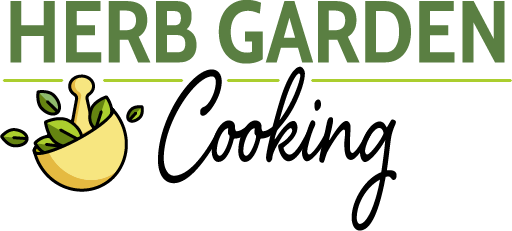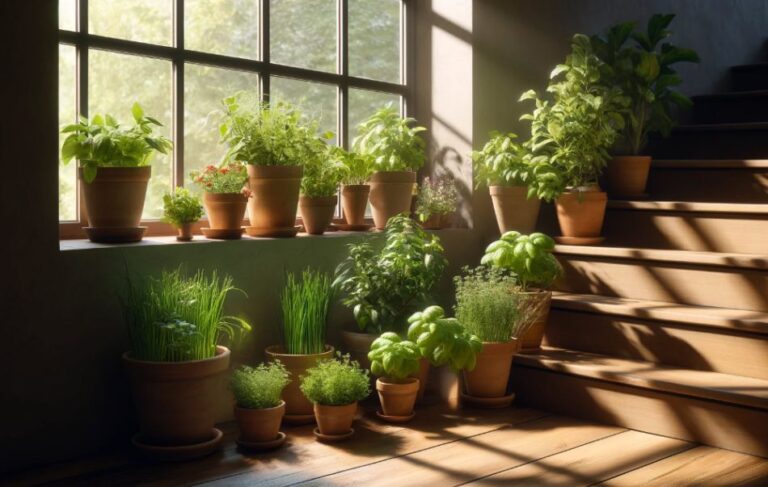This post may contain affiliate links which means I may receive a commission for purchases made through links. I only recommend products that I have personally used. As an Amazon Associate I earn from qualifying purchases. Learn more on my Private Policy page.
Low light is often a factor when indoor herb gardening, as natural sunlight can be scarce. Growing herbs can be challenging in such environments, as they rely on adequate light for photosynthesis.
What are the best herbs for low light conditions?
Mint, tarragon, chives, lemon balm, parsley, cilantro, and thyme are the best indoor herbs for low-light conditions. They adapt to limited sunlight and thrive indoors with as little as 3-6 hours of light daily.
Let’s explore these seven herbs that tolerate low-light environments and discover why they fit your indoor garden perfectly.
Table of Contents
1) Mint
Mint’s ability to tolerate lower light levels makes it one of the best indoor herbs for low-light environments. It thrives in partially shaded areas, making it ideal for homes with limited natural light.
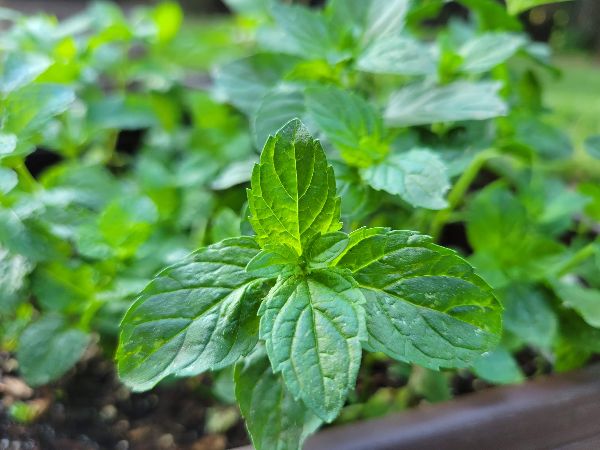
Mint prefers at least 4-6 hours of indirect sunlight daily, although it can get by on as little as 3-4 hours of light.
Peppermint and spearmint are the most common mint varieties for indoor herb gardens. Mint is relatively low-maintenance and can be grown in containers on kitchen windowsills, on countertops, or using artificial grow lights.
Purchase mint variety seeds from SeedsNow.
2) Tarragon
Tarragon is one of the best indoor herbs for low-light conditions due to its adaptability to grow in low-light conditions and without direct sunlight, allowing it to grow even near north-facing windows or in other areas that receive minimal daylight.

Tarragon typically requires at least 4-6 hours of light and grows well in partial shade.
Russian tarragon is better suited for low-light conditions than French tarragon, although it is milder than French tarragon, which is generally considered to have better flavor.
Purchase Russian tarragon seeds from Amazon.
3) Chives
Chives have the ability to adapt to less-than-ideal lighting conditions, making them a popular choice for indoor herb gardens. While they prefer bright light, chives can tolerate moderate light levels but may grow less densely.

Chives will stretch toward any available light source but will still develop their distinctive mild onion flavor even when grown in low-light conditions. Chives require a minimum of 4-6 hours of light daily.
Purchase live chive plants from Amazon or chive seeds from SeedsNow.
4) Lemon Balm
A member of the mint family, lemon balm is an ideal indoor herb for low-light conditions due to its adaptability. While it prefers bright indirect light, it also grows well with limited natural light, making it perfect for shaded spaces.

Lemon balm requires 3-4 hours of light and prefers dappled sunlight or indirect light of moderate intensity. While it may grow more slowly in lower light, it will maintain its lemony scent even under low light conditions.
While lemon balm can adapt to very low light conditions, occasional exposure to moderate or indirect sunlight boosts its vitality when it’s grown indoors.
Purchase live lemon balm plants from Amazon or lemon balm seeds from SeedsNow.
5) Parsley
While parsley prefers full sun, it can handle moderate light levels and adapts well to indoor environments with limited sunlight. Its finely divided leaves maximize surface area for efficient photosynthesis, enabling robust growth even with minimal natural light.

Parsley requires at least 3-5 hours of light daily, and while it prefers full sun, it can manage in lower light conditions, although its growth may be less robust.
Italian flat-leaf parsley is better suited for low-light conditions than curly parsley due to its broader leaves, which are more efficient at photosynthesis in lower light.
Check out my comprehensive guide to parsley for tips on techniques for growing and cooking with this herb.
Purchase Italian parsley plants from Amazon or parsley variety seeds from SeedsNow.
6) Cilantro
Cilantro is well-suited for growing in cooler, low-light conditions and can grow well in kitchen areas with little direct sunlight or under grow lights due to its broad leaf structure. Cilantro requires at least 3-4 hours of sunlight per day.
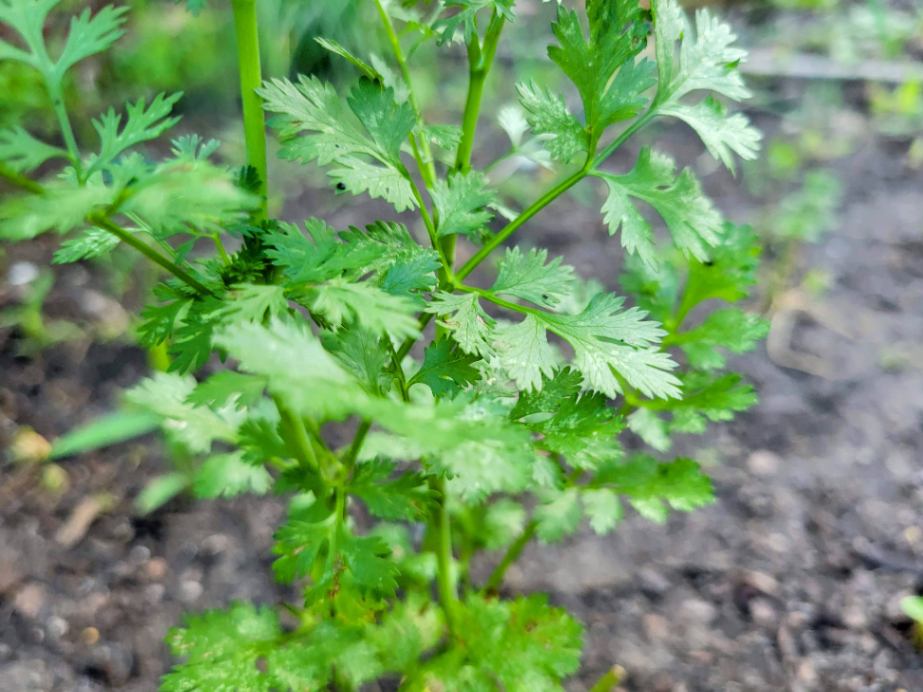
Sunlight exposure influences cilantro’s growth and yield. Too much heat or intense light can cause cilantro to bolt where it prioritizes flowering over leaf growth. Moderate, less intense light conditions and cooler temperatures allow cilantro to focus on leaf production, reducing the chance of bolting.
Purchase live cilantro plants from Amazon or cilantro seeds from SeedsNow.
7) Thyme
Thyme is well suited to growing indoors due to its ability to adapt to low-light conditions. Its hardy nature allows it to grow well indoors despite lacking ample natural light.
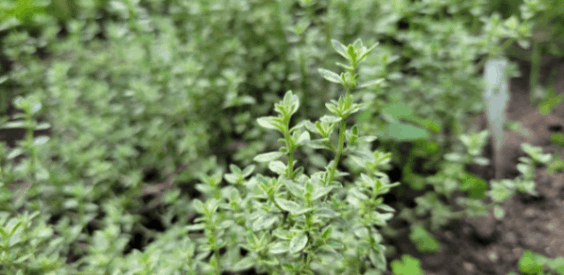
When cultivated in low light, thyme may grow slightly slower, but its flavor and growth are largely unaffected. This versatile herb retains its robust signature flavor profile and essential oils even with minimal sunlight, allowing it to enhance savory dishes and recipes.
While thyme prefers 6-10 hours of light, it is still able to grow indoors with as little as 4-6 hours of light per day.
See my thyme guide for more information on this herb's cultivation and culinary uses.
Purchase thyme plants from Amazon or thyme seeds from SeedsNow.
Managing Legginess in Indoor Herbs
Legginess in herbs refers to plants growing tall and spindly with weak stems and sparse leaves. Inadequate lighting is a common reason for indoor herbs becoming leggy.
Why Does Poor Lighting Cause Legginess?
Herbs require sufficient light for photosynthesis, the process that fuels their growth. In low-light conditions, plants stretch towards the nearest light source, leading to elongated stems and fewer leaves. While helping them reach for more light, this survival mechanism compromises their structural integrity and overall health.
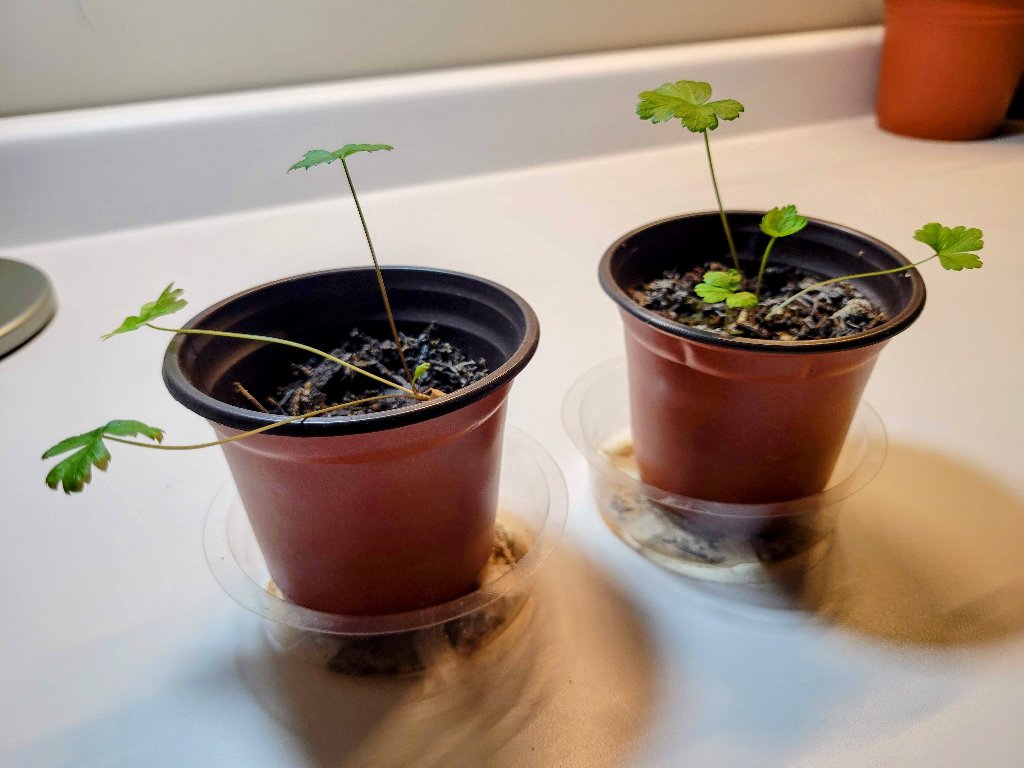
Look for the following signs to determine if your herbs are getting leggy:
- Long, thin stems
- Sparse foliage
- Pale or yellow leaves
- Overall weak appearance
How to Prevent and Correct Legginess
- Optimize Light Exposure
- Place herbs near south-facing windows for maximum natural light.
- Rotate pots regularly to ensure even light distribution.
- Artificial Lighting
- Use grow lights if natural light is insufficient. LED or fluorescent grow lights are effective.
- Position lights close to plants (about 2-4 inches away) and keep them on for 14-16 hours a day.
- Pruning
- Regularly prune leggy herbs to encourage bushier growth.
- Regular Care
- Ensure herbs receive adequate water and nutrients.
- Avoid over-fertilizing, as this can exacerbate legginess.
Legginess in herbs is a clear indicator of insufficient light. By providing adequate lighting, either naturally or through artificial means, and employing proper plant care techniques, you can significantly reduce the risk of legginess and promote healthy, robust growth in your indoor herbs.
Leaf Structure and Efficiency in Low Light
The structure of an herb’s leaves plays a crucial role in its ability to perform photosynthesis, especially in low-light conditions. Broad, dark green leaves are generally more efficient at absorbing light.
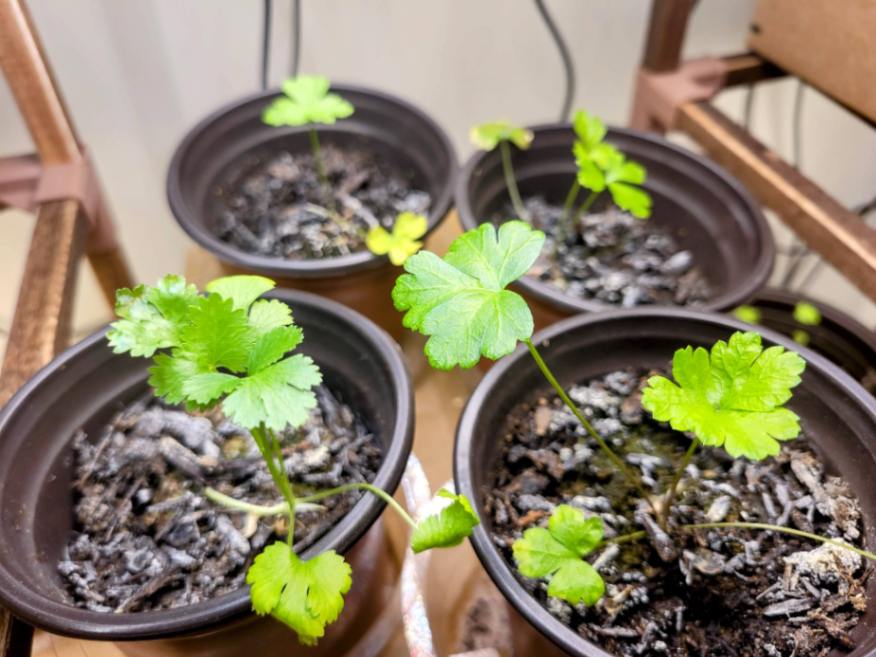
- Herbs like cilantro, parsley, and mint, with their larger and darker leaves, are more adept at capturing limited light. This efficiency partially compensates for the reduced light intensity, allowing these herbs to maintain a reasonable rate of photosynthesis and continue growing, albeit at a slower pace.
- While herbs such as thyme are capable of growing in lower light conditions, herbs with finer and smaller leaves can struggle to perform sufficient photosynthesis more than broad-leafed herbs.
Practical Guidelines for Growing Herbs in Low Light
How Much Light Do Indoor Herbs Need?
For optimal growth, it’s vital to provide indoor herbs with an appropriate duration of light daily. Most herbs require a minimum of between 3 and 6 hours of sunlight per day, but more is better.
Understanding Daily Light Integral (DLI): It’s also crucial to ensure herbs receive the right light intensity. The Daily Light Integral (DLI) is a measure of the total amount of photosynthetically active radiation a plant receives in a day.
We typically use mol/m²/day as the DLI measure in gardening and agriculture. Mol (or Mole) is the number of photons (individual light particles) that are hitting a particular area (a square meter) in a day.
Use the following light requirement guidelines for the low light tolerant herbs discussed above.
| Herb | Min Sunlight Hrs (per day) | DLI (mol/m²/day) | Notes |
|---|---|---|---|
| Mint | 3-4 | 12-15 | Hardy and adaptable to various light conditions. |
| Parsley | 3-5 | 12-16 | Prefers full sun but can manage in lower light. |
| Chives | 4-6 | 14-18 | Can tolerate moderate light levels. |
| Lemon Balm | 3-5 | 12-15 | Thrives in bright light but adaptable. |
| Thyme | 4-6 | 14-18 | Prefers full sun, slower growth in low light. |
| Tarragon | 4-6 | 12-16 | Grows in partial shade. |
| Cilantro | 4 | 12-16 | Prefers cooler, less intense light. |
Monitoring and Adjusting Light Conditions
To take the guesswork out of determining how much light your herbs are getting, you can measure the light using a DLI gardening light meter (Amazon) or by downloading a photo meter app to your smartphone. I use the Photone grow light meter, which suits my needs perfectly.

Regular monitoring of light conditions is essential for healthy herb growth. Keep an eye on the distance between the plants and the lights, and watch for signs of stress, such as stretching or yellowing, which may indicate the need for more light.
Effective Use of Grow Lights
Using grow lights efficiently can greatly enhance herb growth in low-light areas. LED grow lights work well, as you can place your grow lights several inches from the plants to ensure they receive enough light without overheating.
The inverse square law applies to indoor herb lighting conditions, which means that light intensity decreases rapidly with increased distance from the source. Herbs placed farther from the light source receive significantly less light, impacting their growth.
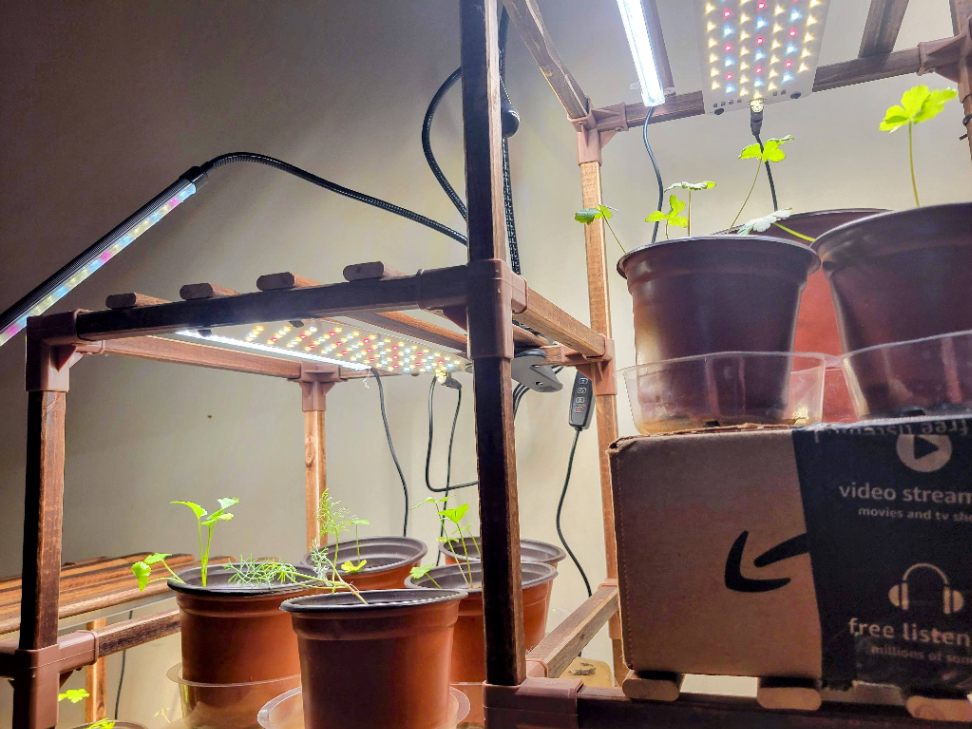
Rotating plants promotes uniform growth and prevents them from leaning toward the light. Providing around 12-16 hours of artificial light per day can compensate for the absence of natural sunlight.
Adjusting the position or lighting duration based on your observations helps maintain an ideal growing environment for herbs, even with limited natural light. The position of the lighting can be adjusted either by moving the grow lights or placing your herb containers on boxes of different sizes to change their distance from the grow lights.
I utilize both of the below grow lights in my indoor herb gardening setup:
Conclusion
Growing herbs successfully in low-light indoor settings requires understanding their light needs and adapting care techniques. Herbs like mint, parsley, chives, and others can thrive indoors with proper light management.
Key strategies include optimizing light exposure, using artificial lighting effectively, and regular pruning to prevent legginess and promote healthy growth. Leaf structure is critical in low-light photosynthesis, with broader leaves being more efficient.
By following specific light guidelines, monitoring conditions, and using grow lights judiciously, gardeners can cultivate a vibrant indoor herb garden, ensuring robust growth and flavor, even in environments with limited natural light.
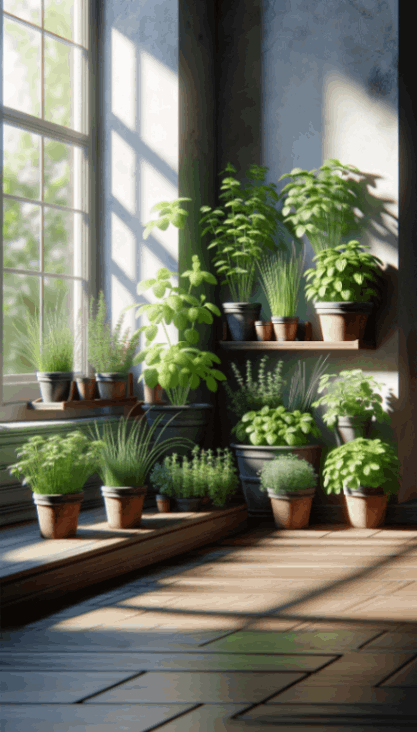
Frequently Asked Questions (FAQs)
Do indoor herbs need direct sunlight?
Indoor herbs do not always need direct sunlight but require adequate light for photosynthesis. Herbs like mint, chives, parsley, and cilantro can grow in low-light conditions, needing 3-6 hours of light daily. They adapt well to indirect sunlight or artificial lights, making them suitable for indoor gardening.
Do herbs like morning or afternoon sun?
Herbs require a minimum of 3-6 hours of sunlight daily, regardless of whether it’s morning or afternoon sun. More is better. The time of day is less important than the amount of light they receive. Herbs like mint, parsley, and cilantro adapt well to varying light conditions, including indirect sunlight or grow lights.
How do you keep herbs from getting leggy?
To prevent legginess, provide sufficient light (natural or artificial), rotate pots for even light distribution, prune regularly, and ensure proper watering and nutrients. Avoid over-fertilizing to prevent weak, spindly growth.
How do you know if indoor herbs aren’t getting enough light?
Signs of insufficient light include long, thin stems, sparse foliage, pale or yellow leaves, and an overall weak appearance. These symptoms indicate the need for better light exposure or grow lights.
Can herbs grow with artificial light?
Herbs can grow in artificial light. LED or fluorescent grow lights can substitute natural sunlight, especially in low-light conditions. Herbs should be placed close to these lights for 12-16 hours daily for optimal growth.
Last Updated on 27 April 2024 by Bob Lee
